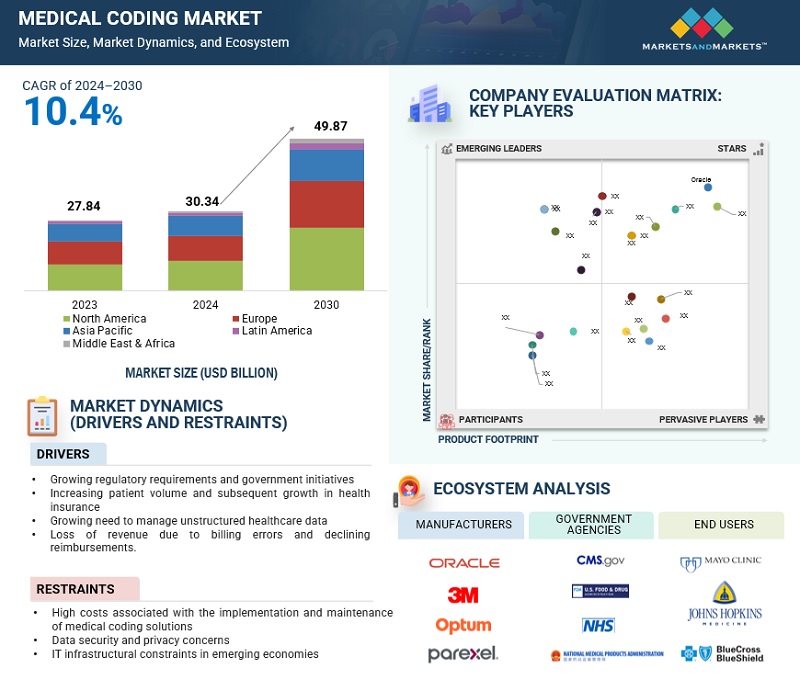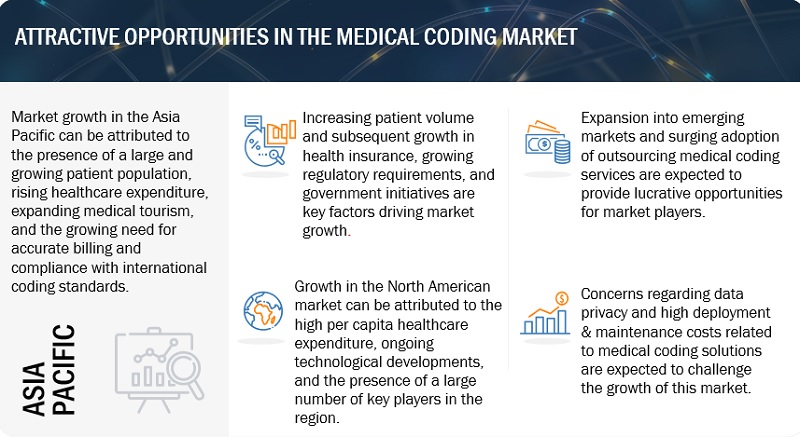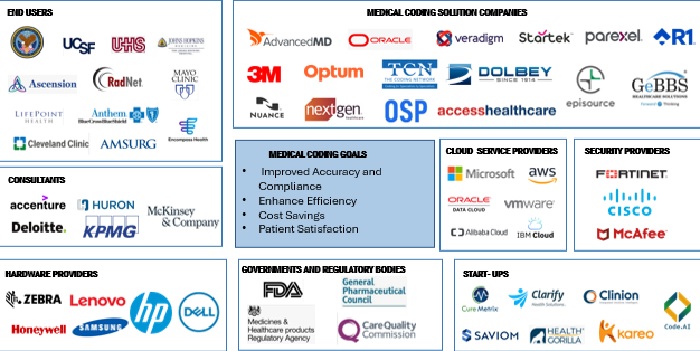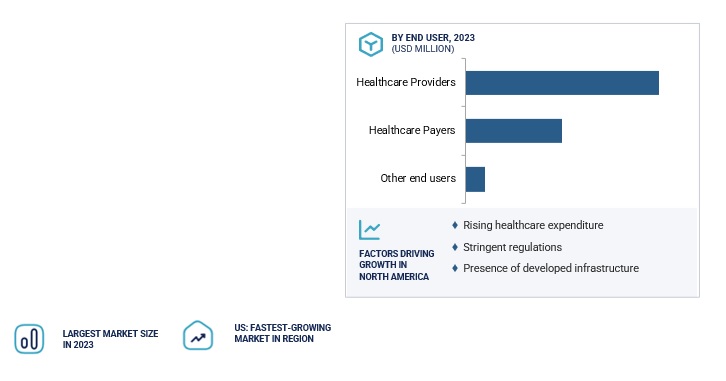Medical Coding Market - Global Forecast 2030
The global medical coding market, valued at US$27.84 billion in 2023, is forecasted to grow at a robust CAGR of 10.4%, reaching US$30.34 billion in 2024 and an impressive US$49.87 billion by 2030. The factors attributing to the surging demand for medical coding solutions include the surge in the volume of patient data from hospitals, clinics, insurance claims, implementation of standardized coding systems like ICD, CPT, HCPCS as mandated by healthcare regulatory bodies, and the increasing reliance on outsourcing medical coding services to minimize costs and boost operational efficiency. The demand for efficient billing & reimbursement is driven by the surging healthcare expenditure, which subsequently boosts the adoption of medical coding solutions.
Global Medical Device Services Market Trend

To know about the assumptions considered for the study, Request for Free Sample Report

Global Medical Coding Market Dynamics
Drivers: Increasing patient volume and subsequent growth in health insurance
The rapidly increasing geriatric population, the growing incidence of chronic disorders such as cancer, heart diseases, etc., and the rising demand for quality healthcare services are the major factors that have increased the burden on healthcare systems globally. As per the World Health Organization (WHO), the global number of people aged 60 and older is expected to rise from 900 million in 2015 to 2 billion by 2050. As per the reports by CDC, chronic diseases like cancer, cardiovascular disease (CVD), diabetes, and respiratory diseases cause approximately 70% of deaths in the US every year. In addition to this, as per WHO, the population aged 65 and over in the European region is estimated to increase from 129 million in 2010 to 224 million by 2050; the number of people aged 85 years and older is expected to rise from 14 million to 40 million.
With a rapid increase in the geriatric population and the subsequent hike in the prevalence of chronic diseases, the number of insurance claims has increased manifold across the globe. Moreover, in the US, with the implementation of the Affordable Care Act (ACA), almost 45 million more people will be eligible for Medicaid or coverage from insurance providers. This will further aid the demand for medical coding solutions. Rising healthcare costs also compel people to opt for health insurance. According to Deloitte Global Healthcare's outlook, spending on healthcare is projected to increase at an annual rate of 5.4%, from USD 7.724 trillion in 2017 to USD 10.059 trillion in 2022. The demand for healthcare insurance is increasing with the rising healthcare spending, subsequently increasing the burden on healthcare systems. The rising volume of insurance claims requires the implementation of streamlined workflows for payment processing. Medical coding solutions can be of significant help in this regard.
Restraints: High costs associated with the implementation and maintenance of medical coding solutions
The adoption of medical coding solutions requires high investments by healthcare providers and payers. Small to mid-sized hospitals find it difficult to afford such solutions due to controlled budgets. These expenses includes the initial purchase of software, its deployment, integration with existing IT systems such as EHRs, and the training of personnel to use the solutions effectively. Technologically advanced medical coding solutions that integrate Al and automation further escalate costs, creating a financial burden for organizations operating with limited budgets. Additionally, ongoing costs related to software updates, adherence to frequently changing coding standards (e.g., ICD-11), and system customization to meet specific regulatory and operational requirements add to the financial strain. Furthermore, the implementation time of these software solutions can take as long as several months. Moreover, the lack of internal technical expertise in the healthcare industry to run these solutions efficiently requires training to maximize the efficiency of medical coding solutions, thereby adding to the cost of ownership of these systems.
Opportunities: Increasing adoption of outsourcing medical coding services
Outsourcing is a popular strategy that healthcare organizations use to limit the rising costs of providing services. With outsourcing, an external contractor assumes the responsibility of managing one or more of a healthcare organization's business, clinical, financial, or hospitality services. The increasing adoption of outsourcing medical coding services is transforming the medical coding market, driven by the need for cost-efficiency, accuracy, and compliance.
Outsourcing medical coding services enables healthcare providers to hand over coding tasks to specialized third-party vendors, helping them reduce costs & burden associated with maintaining in-house teams. This trend is particularly prominent among small and mid-sized healthcare organizations that often lack the resources to invest in advanced medical coding software or hire certified coders. By outsourcing, they can access skilled professionals, up-to-date coding standards, and robust technology platforms without the need for significant capital investment.
Challenges: Issues related to data security and confidentiality
Medical coding solutions frequently manage sensitive patient information, including medical histories, diagnoses, and treatment details. Unauthorized access, breaches, or mishandling of such data can lead to severe consequences, including violations of privacy regulations such as the Health Insurance Portability and Accountability Act (HIPAA) in the U.S. Cyberattacks, phishing attempts, and ransomware incidents targeting healthcare organizations make these risks evenn greater, potentially compromising large volumes of protected health information (PHI).
The Identity Theft Resource Center recorded 1,108 breaches in its 2020 breach list in the US- surprisingly, a decrease of 19% over breaches tracked in recent years. The healthcare sector alone accounted for 23.7% of the total tracked breaches. According to IBM Security's data breach report 2020, an average breach costs healthcare organizations around USD 7.3 million per hack. In the healthcare industry, medical record breaches hold the largest share of overall data breaches, with 2,929,041 records breached in 2020. The Information Commissioner's Office (ICO), an independent body in the UK that upholds information rights, received 700 new cases of data breaches in 2020. The Anthem Inc. Data breach and Accellion FTA Hack are some of the most significant cyberattacks in recent years, jeopardizing 47.76 million patient records altogether, causing USD 81.5 million loss in total.
MEDICAL CODING MARKET ECOSYSTEM
The ecosystem of the medical coding market comprises key companies & startups operating in the market that offer medical coding solutions, cloud service providers, security providers, consultants, hardware providers, government organizations & regulatory bodies, and end users including hospitals, physician practices, ambulatory surgical centers, hospital outpatient facilities, diagnostic and imaging centers, and healthcare payers.

To know about the assumptions considered for the study, download the pdf brochure
The cloud-based segment is expected to grow at the fastest rate in the medical coding market, by deployment mode.
Based on deployment model, the medical coding is segmented into on-premises model and cloud-based model. In 2023, the cloud-based segment experienced the fastest growth in the market. The rapid growth of this segment is driven by their scalability, cost-efficiency, and easy accessibility, making them an increasingly attractive option for healthcare providers. Cloud platforms offers flexibility to the end users allowing them to access the coding tools and data from anywhere at anytime, enabling remote work and collaboration among the teams spread across various regions. Moreover, cloud solutions automatically updates to the coding standards like ICD and CPT, ensuring compliance with evolving regulations without requiring manual intervention. These advantages, coupled with the growing adoption of cloud-based healthcare IT systems, are driving the rapid expansion of cloud-based medical coding solutions.
The hospitals & clinics segment accounted for the largest share of the medical coding market for healthcare providers, by end user.
Hospitals & clinics, ambulatory surgical centers, diagnostics & imaging centers, and others make up the medical coding market for healthcare providers by end user. The hospitals & clinics accounted for the largest share of the medical coding market in 2023. The significant share of this segment is attributed to the increasing volume of patient data and medical claims, which necessitates efficient coding to streamline billing and reimbursement processes, growing need for the integration of coding solutions with electronic health records (EHRs) and practice management systems, shift towards value-based care models. Regulatory requirements like the implementation of standardized coding systems like ICD-10/11 and CPT further drive adoption of these solutions. Non-compliance can lead to significant financial penalties and reputational risks. Moreover, the growing emphasis on data-driven decision-making has made coding solutions indispensable for generating actionable insights from patient data.
North America dominated the Medical coding market in 2023.
The medical coding market is studied for the five major regions: North America, Europe, the Asia Pacific, Latin America, and the Middle East & Africa. The North American region dominated the market due to its high per capita healthcare expenditure, surging number of patients with chronic disorders, and significant investments by government & private entities toward strengthening healthcare infrastructure. The widespread implementation of coding standards such as ICD-10, CPT, and HCPCS, mandated by government bodies like the Centers for Medicare & Medicaid Services (CMS), ensures compliance and consistency in billing and reimbursement processes. Technological advancements such as adoption of AI, ML, and other sophisticated technologies have also boosted the demand for integrated coding solutions in North America. Moreover, the competitive scenario in North America due to presence of a large number of players motivates key market players to develop innovative tools, driving continuous growth in service offerings.

Key Market Players
- Oracle (US)
- Startek (Capital Square Partners) (US)
- R1 RCM (US)
- Parexel International Corporation (US)
- GeBBS (US)
- 3M (US)
- Nuance Communications, Inc. (Microsoft) (US)
- Optum, Inc. (Unitedhealth Group) (US)
- NextGen Healthcare (US)
- Dolbey Systems, Inc.
- The Coding Network, LLC (US)
- OSP Labs (US)
- Precyse Solutions LLC (US)
- Access Healthcare (US)
- Global Healthcare Resource (US)
- Episource (US)
- Edifecs (Talix) (US)
- AdvancedMD (US)
- Vee Technologies (US)
- Omega Healthcare (US)
Recent Developments in the Medical coding Market:
- In October 2024, Tanner Health and Healthliant Ventures partnered with Corti to streamline medical coding, reduce administrative workloads by 80%, and improve billing accuracy.
- In October 2024, Petal acquired Medcom Billing Systems to strengthen its position in medical billing and revenue cycle management across Canada. This partnership integrates Medcom's expertise with Petal's technology helping clients to reduce administrative burdens, enhance billing efficiency, and achieve optimized revenue outcomes with secure, automated workflows.
- In April 2024, XpertDox and Positive Results Billing announced a strategic partnership to deliver AI-powered medical coding software aimed at enhancing accuracy and efficiency in medical billing processes. The collaboration leverages XpertDox's expertise in artificial intelligence and Positive Results Billing's experience in revenue cycle management to streamline coding workflows, reduce manual errors, and ensure compliance with evolving standards.
- In November 2023, AAPC acquired Semantic Health to expand its technology solutions portfolio in healthcare revenue cycle management. This strategic acquisition aims to enhance AAPC's offerings by integrating advanced coding solutions, improving accuracy, and streamlining workflows for healthcare providers.
- In November 2023, R1 RCM expanded its collaboration with Microsoft to integrate Azure OpenAI Service across the R1 enterprise. This partnership led to the development of a large language model application that enhances productivity in physician coding quality assurance by evaluating complex unstructured medical records to predict evaluation and management codes.
Frequently Asked Questions (FAQ):
1. Which are the top industry players in the medical coding market?
The top market players in the global medical coding market are Oracle (US), Startek (Capital Square Partners) (US), R1 RCM (US), Parexel International Corporation (US), GeBBS (US), 3M (US), Nuance Communications, Inc. (Microsoft) (US), Optum, Inc. (Unitedhealth Group) (US), NextGen Healthcare (US), Dolbey Systems, Inc. (US), The Coding Network, LLC (US), OSP Labs (US), Precyse Solutions LLC (US), Access Healthcare (US), Global Healthcare Resource (US), Episource (US), Edifecs (Talix) (US), AdvancedMD (US), Vee Technologies (New York), Omega Healthcare (US).
Which offerings have been included in the medical coding market report?
This report contains the following offerings:
- Software
- Services
3. Which region dominates the global medical coding market?
The global medical coding market is bifurcated into North America, Europe, the Asia Pacific, Latin America, and the Middle East & Africa. North America holds a substantial share, and the Asia Pacific is expected to register the highest growth rate during the forecast period.
4. Which end users have been included in the medical coding market report?
The report contains the following industry segments:
- Healthcare Providers
- Healthcare Payers
- Others
5. What is the total CAGR expected to be recorded for the medical coding market during 2024–2030?
The market is expected to record a CAGR of 10.4% from 2024–2030.
To speak to our analyst for a discussion on the above findings, click Speak to Analyst
















Growth opportunities and latent adjacency in Medical Coding Market